This Post May Contain Affiliate Links. Please Read Our Disclosure Policy.
Sourdough Rye Bread is perfectly soft and chewy, with a deep golden crust and wonderfully complex flavors! It’s a great homemade bread for sandwiches, toast, or just snacking on. I’ve included all the tips and tricks you need to be successful in making your own at home.
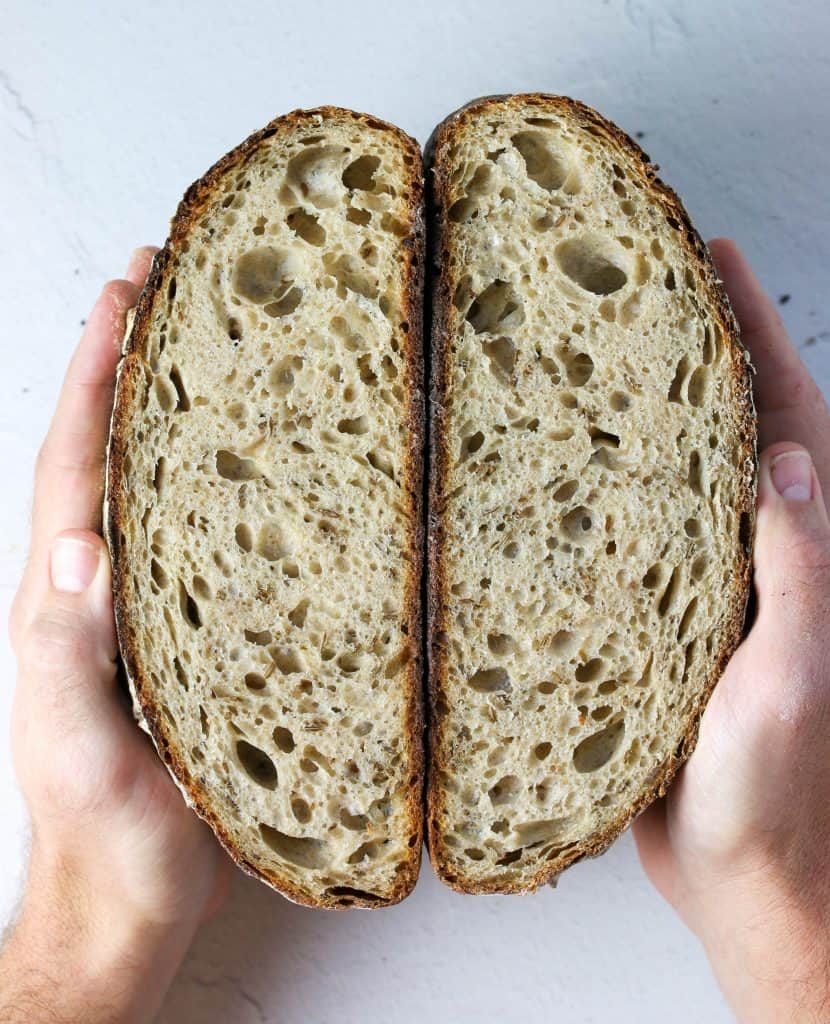
I have fallen head over heels for sourdough bread in all it’s wonderful shapes, sizes, and forms. Something about the slightly sour flavor gives classic recipes a refreshing and exciting twist. I have used my Sourdough Starter to make Sourdough Focaccia for Italian nights, Whole Wheat Sourdough Sandwich Bread for healthier lunches, and even Sourdough Cinnamon Rolls for Sunday mornings.
Today I’m sharing my recipe for Sourdough Rye Bread. This bread has extra depths of flavor thanks to the rye flour, plus it gets the most incredible brown crust. The sourdough and rye are perfect complements to each other, making for an addictive homemade bread!
Table of contents
- What is sourdough?
- Rye flour 101
- Is sourdough rye bread better for you?
- Make your sourdough starter…
- Ingredients Needed
- Start With An Active Starter
- Make the dough
- Add the caraway seeds
- Bulk Fermentation
- Shaping The Dough
- Second rise
- Score and bake
- Recipe Tips
- Why didn’t my dough rise?
- Recipe FAQ’s
- More sourdough recipes
What is sourdough?
Sourdough is basically an ancient way of making bread. Sourdough doesn’t rely on commercial yeast (aka those little packets you have bought at the store), but on wild yeast. Wild yeast is everywhere around us and even on us!
By simply combining flour and water, you create a live fermented culture from the wild yeast found on the grains of the wheat that the flour is made from. The more it is “fed”, meaning fresh flour and water, allows the wild yeast to multiply.
Because sourdough relies on wild yeast, the process can take much longer than commercial yeast bread recipes. But the complex flavor and texture is far superior of any other bread you will ever eat.
For more Sourdough 101: What Is Sourdough?<– click here.
Rye flour 101
Rye is similar to wheat, in that it has three layers – endosperm, germ, and bran. Rye flour can come in varying degrees of color – from light, medium to dark – based on how much of the rye kernel used.
This bread adds onto the flavors and texture of sourdough by adding rye flour. Rye flour is a grain that has less gluten than typical flour, which means that breads with 100% rye flour are usually tough and don’t rise well. But when you mix rye flour with bread flour, you get the wonderful flavor of rye with the soft, moist inside of traditional bread.
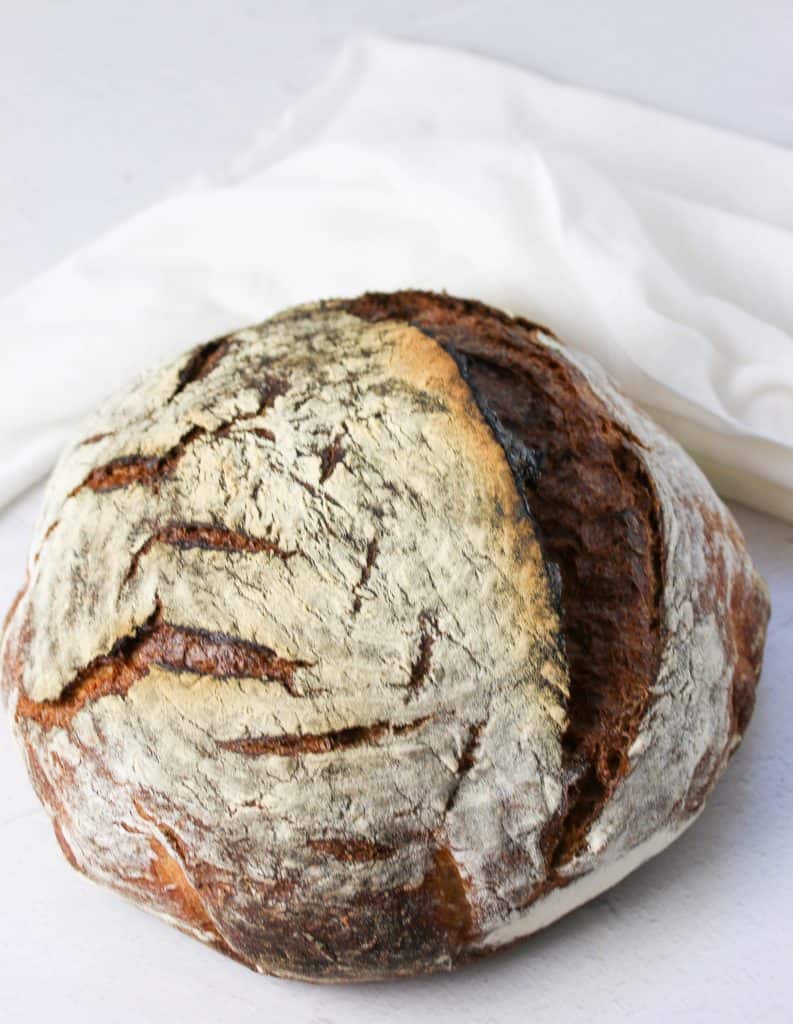
Is sourdough rye bread better for you?
Yes. 1000% yes. Sure at first glance, the nutrition label might look the same to conventional bread. But the long fermentation process is what has sourdough sailing past the conventional bread loaves by a mile for its health benefits. Plus it’s made with just a few simple ingredients compared to store-bought bread that has added chemicals and preservatives.
Whole grains, in general, that bread is made with can contain lots of great minerals. But the body can have a hard time absorbing those minerals due to phytic acid that is present in grains. But the lactic acid created from the fermentation process helps to break down the phytic acid allow your body to be able to absorb more of those minerals than you would be able to with bread made from commercial yeast.
Also, sourdough bread can be much more easily digested and enjoyed, especially those with a gluten sensitivity. The long fermentation process helps to already start the process of breaking down the gluten in the bread making it much easier to digest.
This bread also has the added benefits of rye flour, which is full of extra nutrients, vitamins, and soluble fiber. It is harder to refine than wheat, so it keeps many of the nutrients that wheat flour does not. So more vitamins, minerals, and it’s easier to digest. Basically, sourdough rye bread is awesome.
Make your sourdough starter…
If you haven’t gotten around yet to making your sourdough starter then let’s get going! What are you waiting for? It will take about 5 days to make your starter before you can attempt this bread. But it will be worth it. Here is the full guide on How To Make Sourdough Starter From Scratch.
Once you have your starter raring to go then you will need to feed and mantain your starter.
Want to jump in to sourdough but don’t want to make your own starter? Totally fine! Just buy a sourdough starter and it will be ready to use in a couple days.
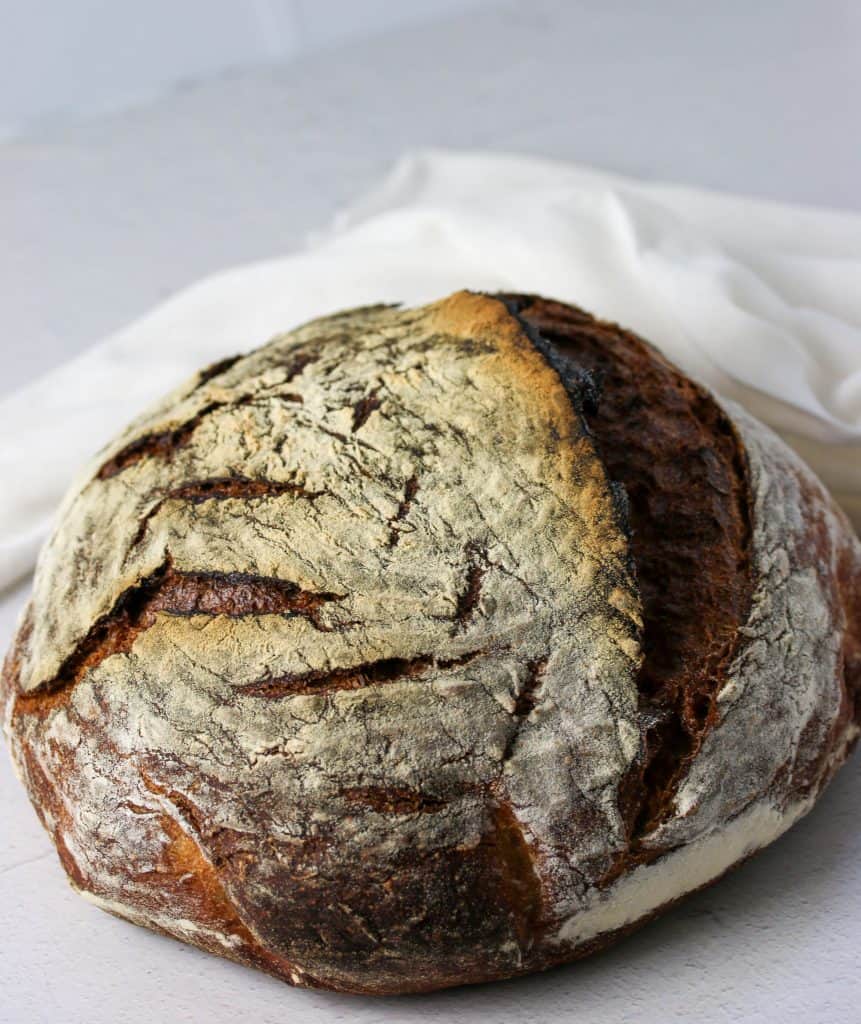
Ingredients Needed
- Sourdough Starter – Make sure you start with an active, bubbly sourdough starter. I have two ways to tell when your starter is active below.
- Water – Make sure you use warm water. If you use cooler water it will take longer to rise.
- Honey – I like to use raw honey, this helps to feed the yeast in your starter so it can rise.
- Rye flour – I used a light rye flour, so it’s a great way to ease into baking with whole grains if you’re new to it but you can use any type of rye flour here, it will just affect the color of the bread and somewhat of the texture.
- Bread flour – Bread flour has a higher protein content than regular AP flour, which can help to develop the necessary gluten that gives the bread structure. The whole grains in the rye flour can inhibit gluten production so using bread flour with it helps to give the dough structure so it can rise properly.
- Kosher Salt – Salt is important not just for flavor but also inhibiting the yeast production. Without salt, your yeast can cause your bread to become overproofed. Kosher salt has larger granules than regular table salt, so if you use table salt use less. I like kosher salt because it has no additives and a purer taste and the granules are easily mixed in.
- Caraway seeds – These are optional but to me rye bread needs to that have that caraway taste!
Start With An Active Starter
In order to get a tall lofty loaf with a nice crumb, you need to make sure your starter is nice and bubbly. Now if you’re like me you like to keep in the fridge all week and bake on the weekends. But using a starter straight from the fridge isn’t active enough to produce a nice, big loaf in the end. So its important to get it active again and give it a few feedings before you use it.
So how do you know when your starter is ready to use for your dough? Well I have two ways for you tell.
The Rubberband Trick
I like to put a rubberband around where the starter begins, and then I can easily tell when the the starter is doubled.
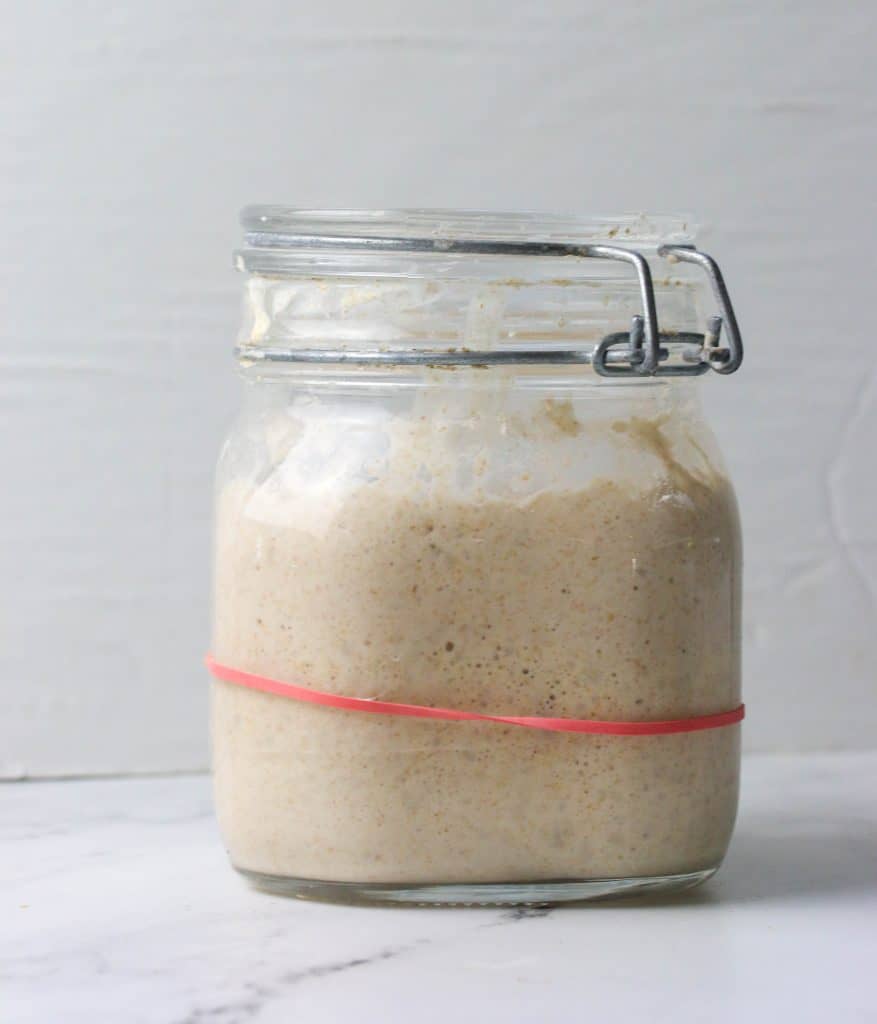
The Float Test
I also like to give my starter the float test. This just means to take a small amount and place it gently into a small dish of water and see if it floats. If it doesn’t, then you may need to give your starter more time and more feedings. If it does, then it’s good to go. But I like to use the rubberband trick first and this is more reliable. But the float test is a nice backup!
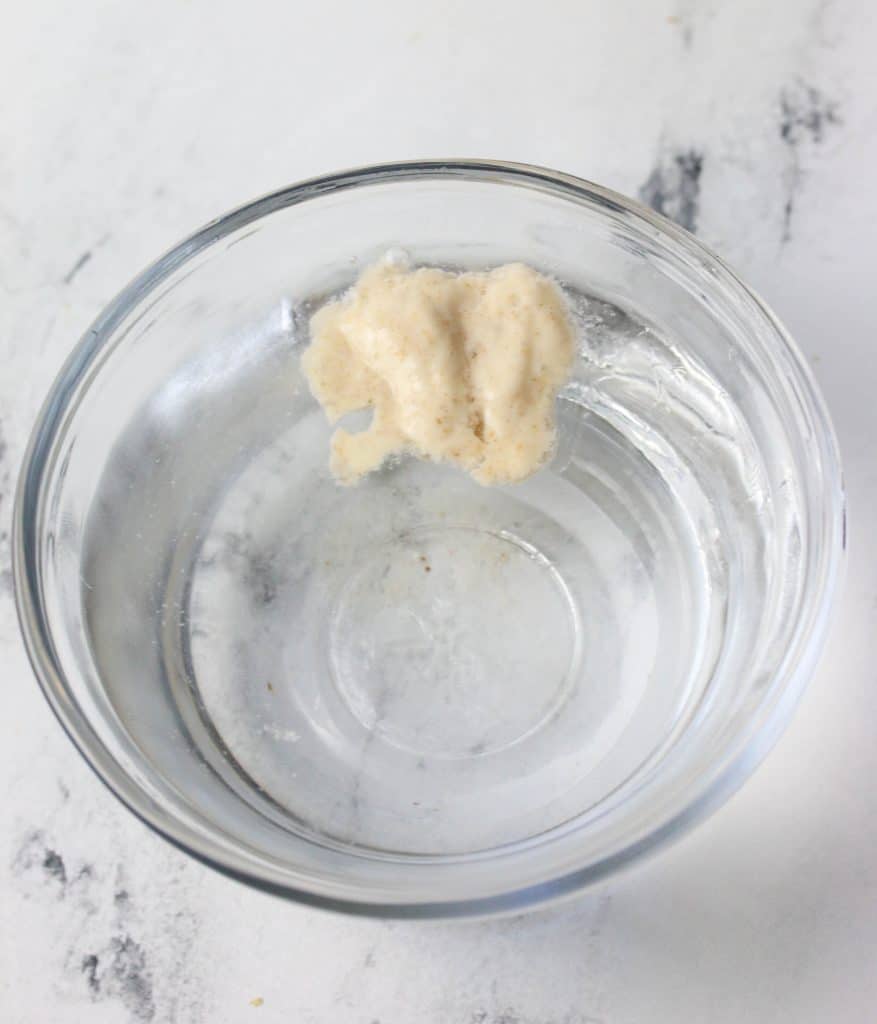
Make the dough
Ok now that your starter is ready time to make that dough! You want to first stir together your active starter and water. Then stir in the flour and salt. Use your hands to squish everything together until all the flour is absorbed. Then cover with a damp towel and let the dough rest for 30 minutes.
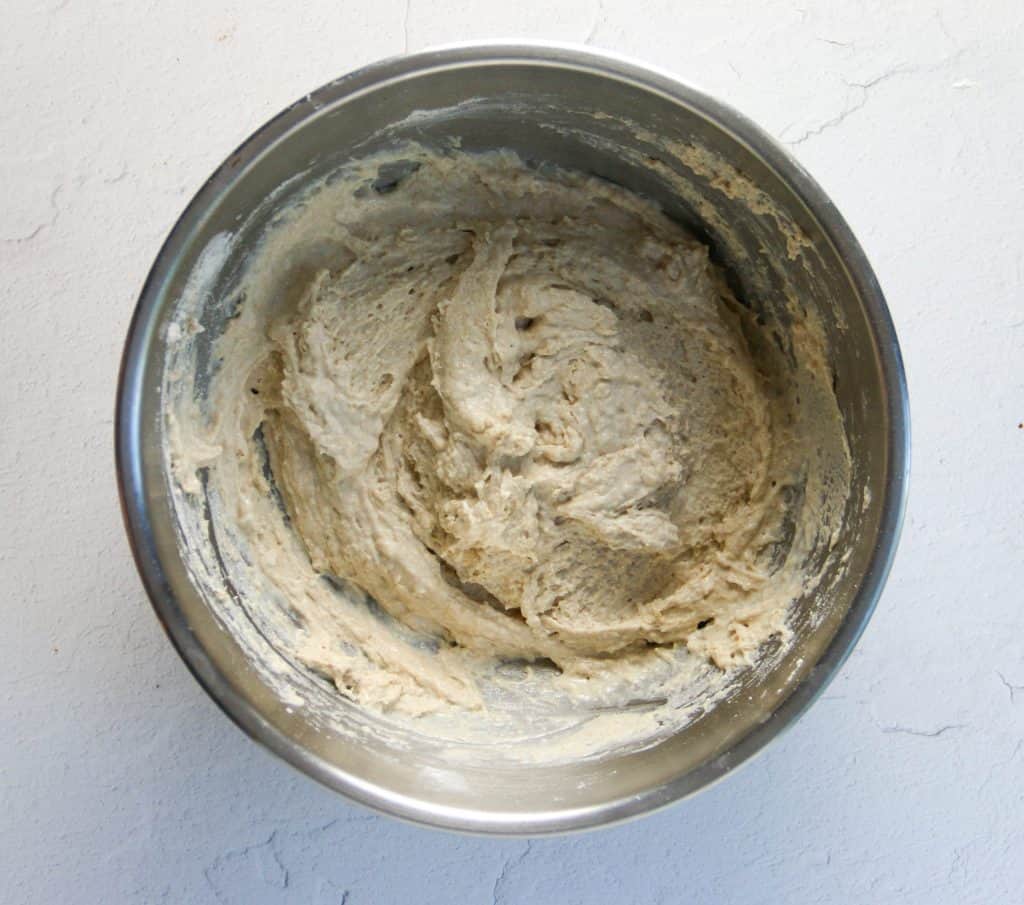
Add the caraway seeds
After the 30 minute rest, add the caraway seeds and work in the seeds with your fingers. Then work into a smooth ball.
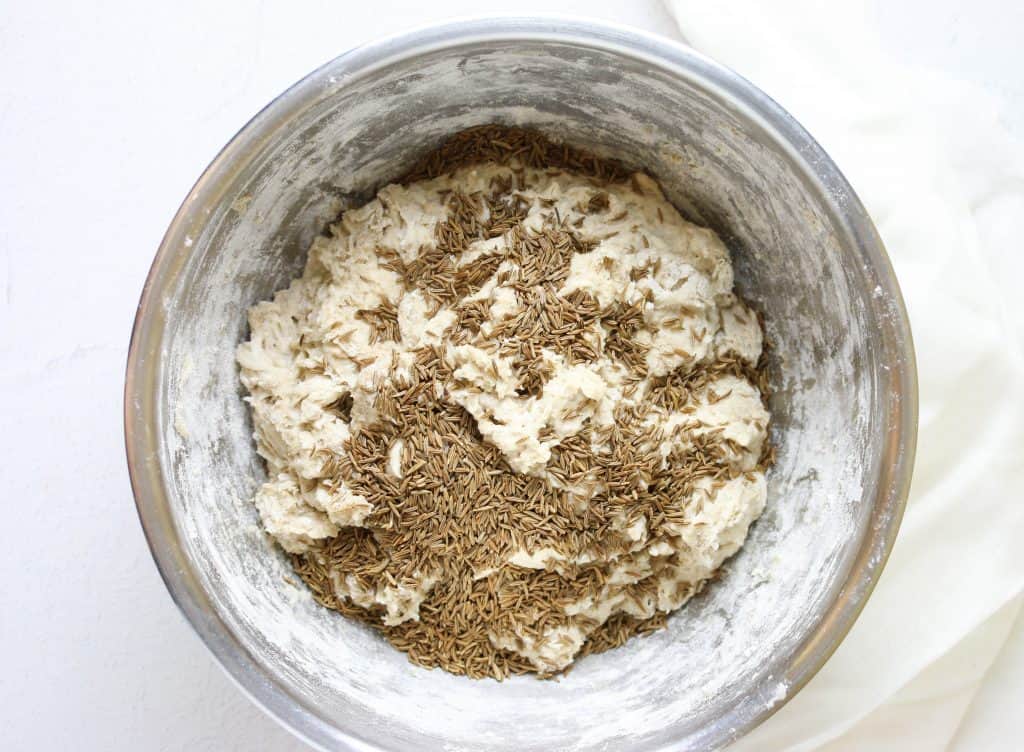
Bulk Fermentation
Now it’s time for the rise! Cover the bowl with a damp towel and let it rise at room temperature for 6-8 hours, preferably overnight. The dough should double in size and no longer look dense.
If you want a little more structure and height, stretch and fold the dough 30 minutes into the rise. Begin by pulling up on the edge of the dough as high as you can stretch it without tearing and fold it in the middle of the dough. Continue doing this around the outside of the dough until you have completed one complete circle. Repeat this technique 2 to 3 times, spaced about 45 minutes apart.
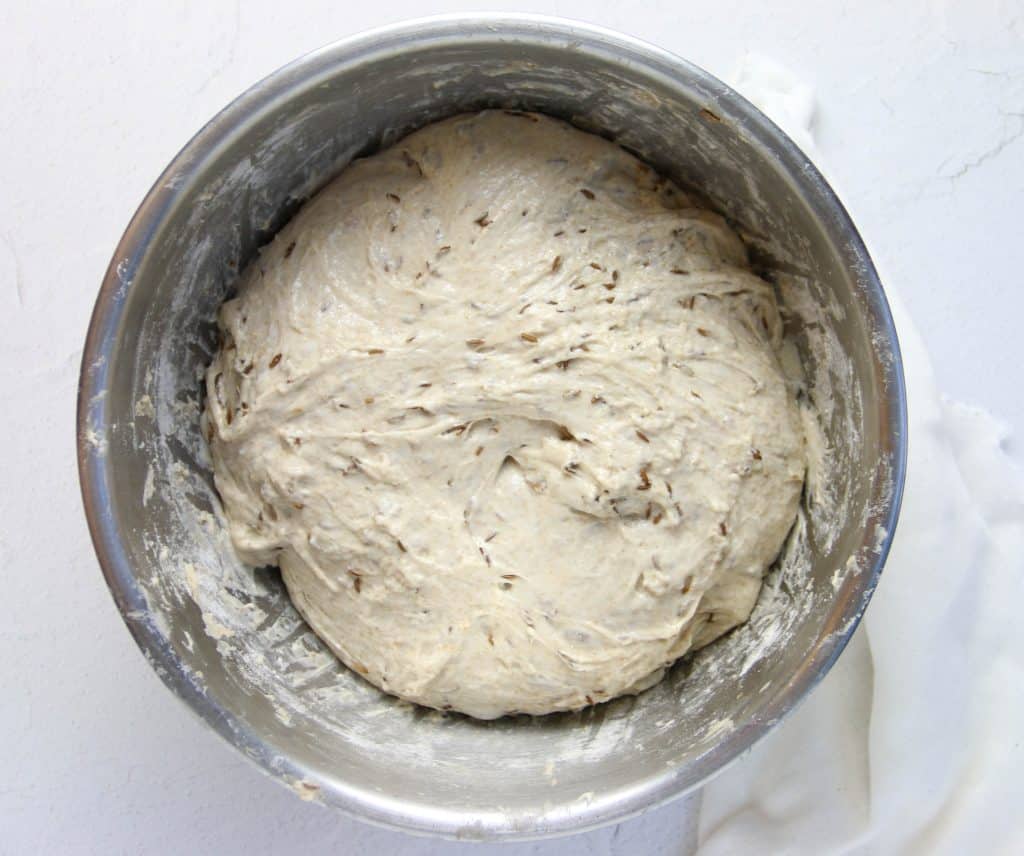
Shaping The Dough
After the dough has doubled in size, it’s time to shape the loaf. Start by scraping the dough onto a lightly floured surface. Use your hands to shape the dough into a round. Do this by starting at the top and folding the dough toward the center. Turn the dough slightly and fold over the next section of dough. Repeat this until you have come full circle and you have a nice round of dough.
Flip the dough over and let rest for 5 to 10 minutes. Meanwhile line an 8-inch bowl with a towel and dust with flour. With floured hands, gently cup the dough and pull it toward you in a circular motion to tighten its shape. Using a bench scraper, place the dough into the bowl, seam side up.
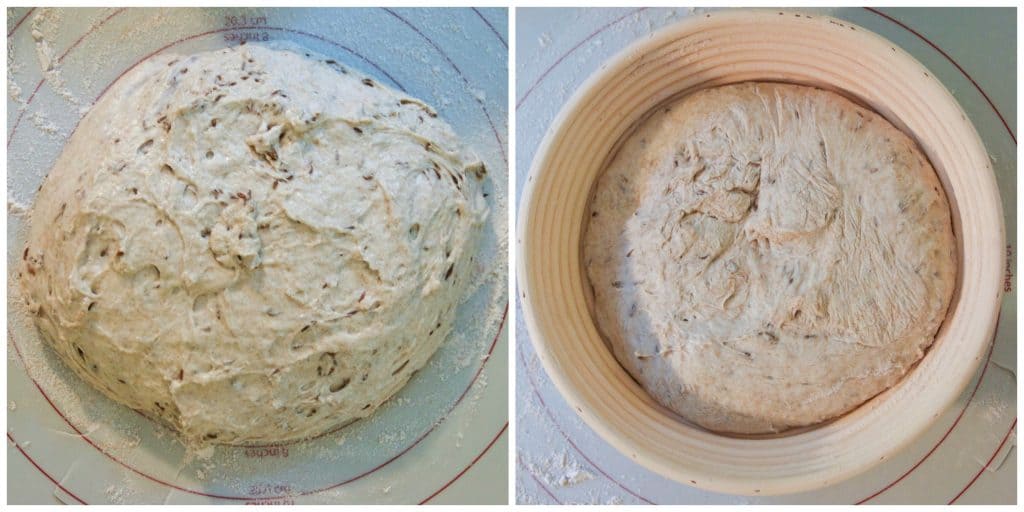
Second rise
Now it’s time for the second rise. Cover the bowl and let rest for 30 minutes to 45 minutes.. The dough is ready when it looks puffy, and has risen slightly but has not yet doubled in size. Nearing the end of the rise, preheat the oven to 400oF.
Score and bake
Once the dough has risen, place a sheet of parchment over the dough and flip the bowl to release the dough. Sprinkle the dough with flour and gently rub the surface with your hands. Using a bread lame, or the tip of sharp knife score the dough. I keep it simple and do 4 cuts, but you can get creative! Then use the parchment paper transfer the dough to your dutch oven.
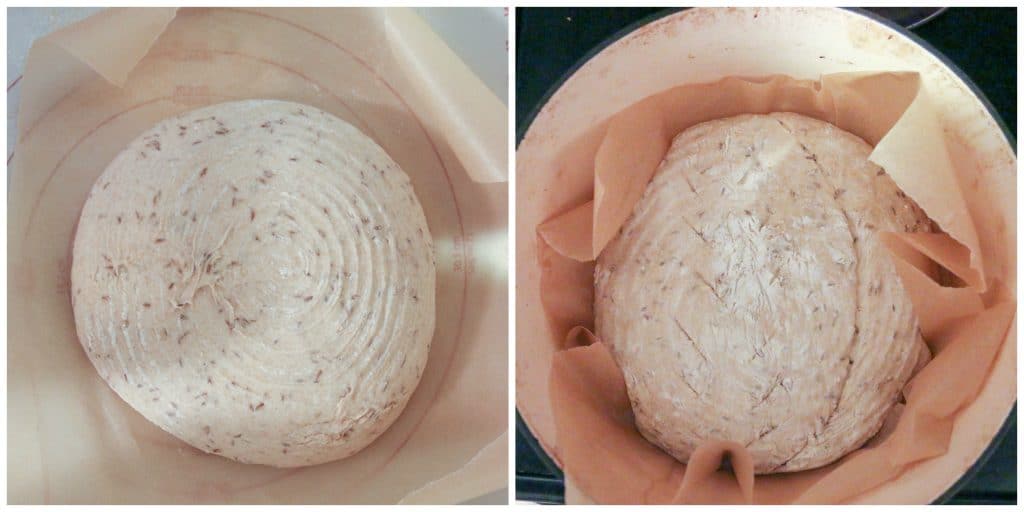
Bake the dough on the center rack for 20 minutes, covered. Then remove the lid and continue baking for 20-30 minutes. At this point the bread should be done. However, if you want extra crispy crust, remove the bread from the oven, remove the loaf from the pot, and bake the bread on the oven rack for an extra 10 minutes. (My crust is always dark at this point, so I skip this step).
Last, transfer the bread to a wire rack and cool for at least 1 hour before slicing.
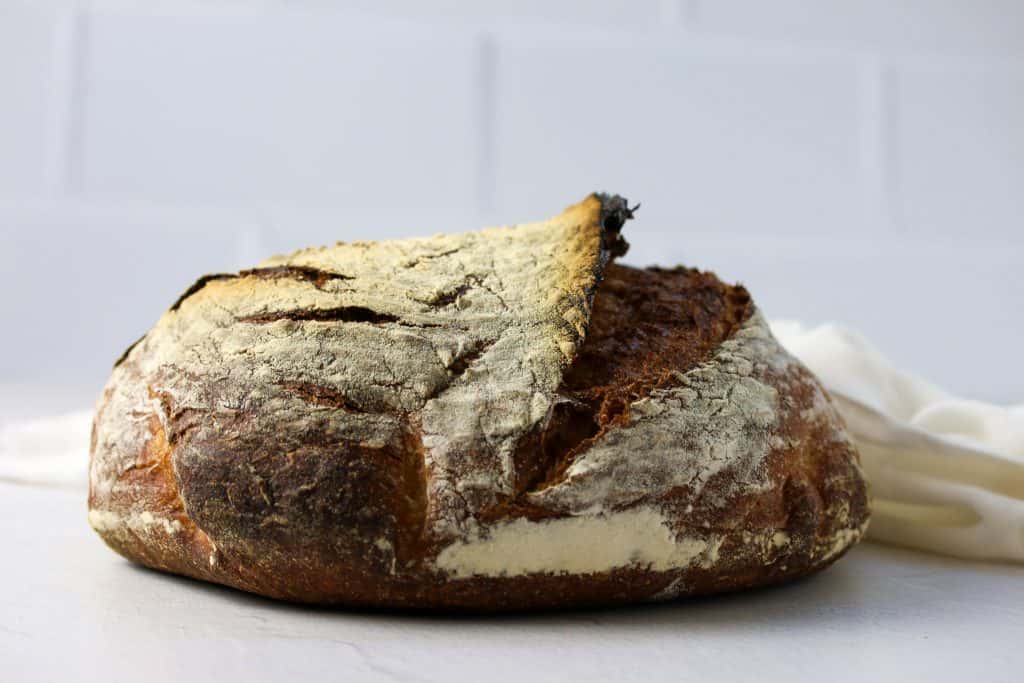
Recipe Tips
- Make sure your starter is active before you start. Drop a small piece in a bowl of water to see if it floats. It it does, then it’s ready! If not, then it may need 1-2 more feedings.
- Measure your flour using a kitchen scale . You can use measuring cups but for best accuracy it’s better use a kitchen scale and weigh out your flour. This ensures you don’t overmeasure, which can result in dense rolls. You can read my post on How To Measure Flour here.
- Use a large mixing bowl! This dough will expand quite a bit. So the bigger the better.
- Use a damp towel. You don’t want the dough to dry out on top creating a film that will prevent the dough from rising.
- Use the stretch and fold technique. Since this bread uses rye flour, it doesn’t rise as high as other breads without a little extra help. For extra height and structure in the bread, use the stretch and fold technique described in the instructions.
Why didn’t my dough rise?
- Starter wasn’t ready: This could be because your sourdough starter wasn’t quite bubbly and active enough. Be sure to do the “float test” before you begin.
- Cold kitchen: Another culprit could be a cold kitchen! If your kitchen is cold the bread will take longer to rise. Ideally, your kitchen should be around 70°F.
- Overproofed: If you overproof during the second rise, then there will be nothing left for the bread to do, and you will get no rise. So make sure to not let the dough rise for more than 30-45 minutes during the second rise.
Recipe FAQ’s
I highly recommend sticking to bread flour in this recipe since rye flour naturally does not rise high. The bread flour will give the bread extra lift and structure.
Sourdough rye bread can be stored at room temperature in an air-tight container or wrapped in plastic wrap. It is best if eaten within the first 3-4 days, but is should stay good for up to 1 week.
Sourdough rye bread can be stored at room temperature in an air-tight container or wrapped in plastic wrap. It is best if eaten within the first 3-4 days, but is should stay good for up to 1 week.
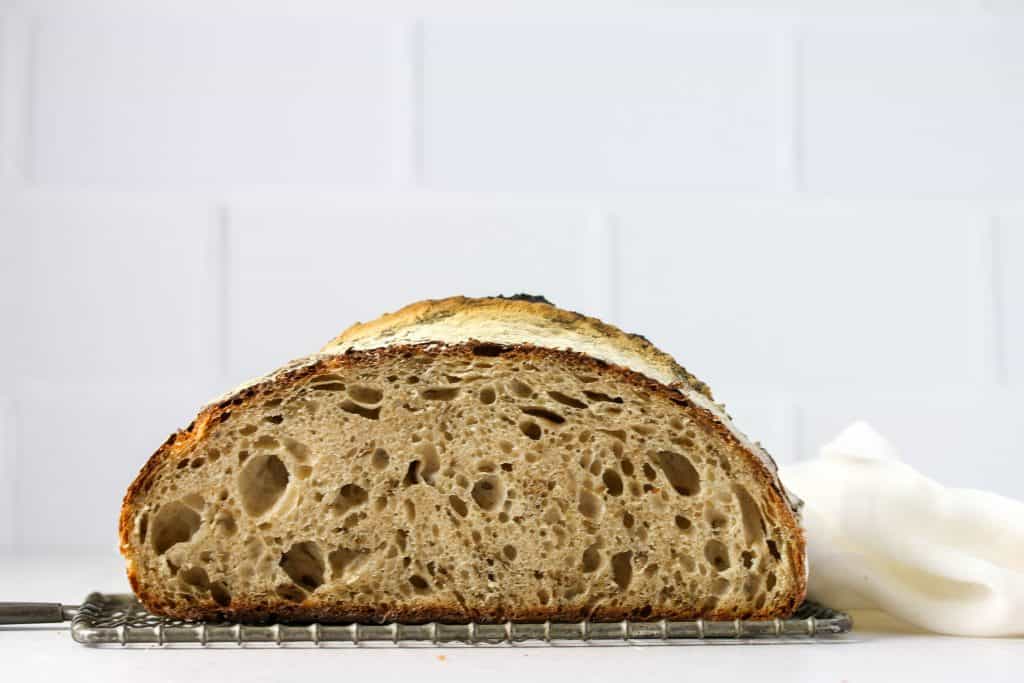
More sourdough recipes
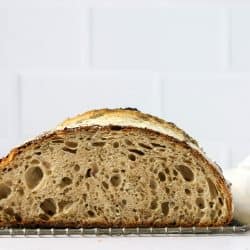
Sourdough Rye Bread
Ingredients
- 50 g (¼ cup) (1/4 cup) bubbly, active starter
- 365 g (1½ cups +1 tsp)warm water
- 20 g (1 tbsp) honey
- 106 g (1 cup) whole grain rye flour or light rye flour
- 400 g (3 ⅓ cups) bread flour
- 9 g (1½ tsp) kosher salt
- 3 tbsp caraway seeds
Instructions
- Make The Dough. Whisk the starter, water, and honey together in a large bowl. Add the flour and salt. Squish everything together with your hands until all of the flour is absorbed. Cover with a damp towel and rest for 30 minutes.
- Add Caraway. After the 30 minute rest, add the caraway seeds and work in the seeds with your fingers. Then work into a smooth ball.
- Bulk Rise. Cover the bowl with a damp towel and let rise overnight at room temperature. This will take about 6 to 8 hours (at 70oF, 21oC). The dough is ready when it no longer looks dense and has doubled in size. Optional: Stretch and fold the dough. About 30 minutes into the bulk rise, stretch and fold the dough for added structure and height. Begin by pulling up on the edge of the dough as high as you can stretch it without tearing and fold it in the middle of the dough. Continue doing this around the outside of the dough until you have completed one complete circle. Repeat this technique 2 to 3 times, space about 45 minutes apart.
- Shape. After the bulk rise, remove dough from bowl and place onto a lightly floured surface. Shape into a round. Start at the top and fold the dough toward the center. Turn the dough slightly and fold over the next section of dough. Repeat until you have come full circle. Flip the dough over and let rest for 5 to 10 minutes. Meanwhile line an 8-inch bowl with a towel and dust with flour. With floured hands, gently cup the dough and pull it toward you in a circular motion to tighten its shape. Using a bench scraper, place the dough into the bowl, seam side up.
- Second Rise. Cover the bowl and let rest for 30 minutes to 45 minutes.. The dough is ready when it looks puffy, and has risen slightly but has not yet doubled in size. Nearing the end of the rise, preheat the oven to 400oF.
- Score. Place the parchment over the dough and invert the bowl to release. Sprinkle the dough with flour and gently rub the surface with your hands. Using a bread lame, or the tip of sharp knife score the dough. I keep it simple and do 4 cuts, but you can get creative! Use the parchment paper transfer the dough to your dutch oven.
- Bake. Bake the dough on the center rack, in a preheated 400oF oven, for 20 minutes, covered. Remove the lid and continue to bake for 20-30 minutes. Optional: Remove from oven, and remove the loaf from the pot and bake the crust for an additional 10 minutes to crisp the crust. (My crust is always dark at this point, so I skip this step). Transfer to a wire rack. Cool for 1 hour before slicing.
Notes
- Make sure your starter is active before you start. Drop a small piece in a bowl of water to see if it floats. It it does, then it’s ready! If not, then it may need 1-2 more feedings.
- Measure your flour using a kitchen scale . You can use measuring cups but for best accuracy it’s better use a kitchen scale and weigh out your flour. This ensures you don’t overmeasure, which can result in dense rolls. You can read my post on How To Measure Flour here.
- Use a large mixing bowl! This dough will expand quite a bit. So the bigger the better.
- Use a damp towel. You don’t want the dough to dry out on top creating a film that will prevent the dough from rising.
- Use the stretch and fold technique. Since this bread uses rye flour, it doesn’t rise as high as other breads without a little extra help. For extra height and structure in the bread, use the stretch and fold technique described in the instructions.
- Storage: The loaf is best consumed within a week, stored in a plastic bag at room temperature. Otherwise freeze for up to 3 months.
- Adapted from Artisan Sourdough Made Simple
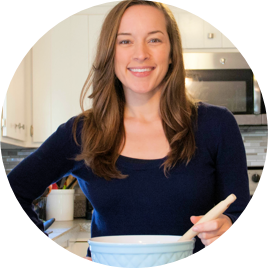
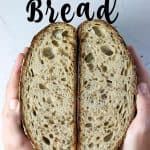
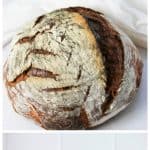
Lidiia says
Hello! It’s going to be my first bread, and I want it to turn out nice so bad 😅. How can I replace honey? And what to do if I don’t have Dutch oven 🥲? Thank you 🤍
Heather says
Hi Lidiia, you can replace the honey with sugar instead. And here is an article you might find helpful on how to bake the bread without a dutch oven. I usually will bake in a cast iron or on my pizza baking stone. I try to create steam then in the bottom by placing ice cubes in a 9×13 pan or roasting pan underneath. Hope that helps!
Sandy Houle says
Great recipe, Heather! I used the medium rye with stretch and folds, bulk fermentation for approximately 6 hours, then into the fridge for overnight. In the morning, I popped the bread into my clay cloche. I did a cold start at 450° for 55 minutes, then about 10-12 minutes with the lid off. Beautiful crumb and rise. Another keeper of a recipe! Thanks!
Heather says
aw wonderful Sandy!! I’m so happy to hear that!!!
Sandy Houle says
Can I use a medium rye flour in this recipe?
Heather says
Yes I think that should be fine!
Jenn S says
Great recipe! II have made this 6 times in just a few weeks, we can’t stop eating it/sharing it. I used molasses instead of honey.
Thank you Heather!
Heather says
oh wow Jenn!! 6 times already?! Good for you 🙂 and yay! I’m so happy you loved it. And I’ll have to try with molasses sounds amazing!!
Melissa Laurence says
When is the right time to put this dough in the fridge? During bulk rise? I made it at 3pm, so can I put it in the fridge around 10pm when I go to bed and bake tomorrow morning?
Heather says
Hi Melissa, I usually let the dough rise at room temperature but If you’re going to let it bulk rise in the fridge then yes you would want to put it in the fridge once the dough is assembled and I would do it after the stretches and folds then place in the fridge.
Tom says
Do you autolyse in this recipe?
Is it okay to use 100% rye starter ?
Heather says
100% rye starter may make it more dense. I only use the autolyse method for the 30 minutes – then proceed with adding the caraway seeds. Hope that helps!
Sara says
Best sourdough loaf I’ve ever turned out. Thank you for an easy great recipe!
Heather says
amazing Sara!! So happy to hear it!!
Ginger says
If I decide to use the stretch and fold technique how long should I allow for the bulk ferment when the last stretch and fold is complete? Thanks!
Heather says
Hi Ginger, so you would still allow for a total of 6-8 hours of total ferment time regardless of if you’re doing the stretch and fold during that time.
Donna says
Do you preheat the oven with the Dutch oven in it or does the dough go into a cold Dutch oven?
Thanks!
Heather says
I’ve done it both ways – but for best results I like to preheat my Dutch oven first up to 45 minutes.
Kelly says
First attempt: BEST RYE BREAD EVER! Thank you! Easy and turned out wonderful.
I have 3 starters: white flour, rye, and a whole wheat.
I used 50/50 white and rye for my rye loaf.
Second attempt: Since I loved the add of the honey, and cannot find a decent sourdough honey wheat, I swapped out the rye ingredients for KA white and red whole wheat flour (50/50grams each), and used my whole wheat starter.
I wish I could add pics of the gorgeous loaf I just pulled out of the oven!
Thank you again for the recipe! Will keep you posted on the honeywheat.
Heather says
Oh that’s amazing Kelly! I’m so glad you loved it!!
Mary says
Best sourdough rye bread I’ve ever made! Turned out great! I made it because I could make it in 1 day( with the help of my proofing oven setting) and I wanted rye bread for dinner.
Heather says
Aw that’s awesome to hear Mary!!
Mike says
I,m on my 5th loaf…..your recipe is awesome, I can’t make it fast enough for family, thanks
Heather says
wow 5th loaf?! That’s awesome!! I’m so glad to hear 🙂
Lisa says
Is this a very wet dough? I’m now questioning myself with the food scale measurements. Haha. It’s quite sticky when I folded in the caraway, sticking to my fingers. Want to make sure I’m on the right track….although I’m sure you won’t see this tonight! Hahaha. Thanks, looking forward to baking and eating tomorrow!
Heather says
Hi Lisa, yes this dough can be on the wetter side, but will firm up as it rises.
Natalie W says
Excellent, easy to do recipe and very tasty. Very happy I can use my sourdough starter and not instant yeast.
Heather says
thanks Natalie! I’m so glad you loved the recipe!
Glenda says
Wow! Best rye I’ve ever eaten, and the recipe is so easy to follow! Thank you for this recipe!
Heather says
aw that’s wonderful to hear Glenda!!
Greg in VT says
Heather,
Absolutely the best rye bread i’ve ever made!
I used my own 2-year old rye starter and molasses instead of honey. Also I cut the caraway down to 2 Tbsp.
The “chew” is superb, as well as the depth of flavor. I’ll never buy store-bought again.
Heather says
that’s so awesome to hear Greg!! Glad you loved the recipe as much as we did,…and love the idea of adding molasses as well. YUM!
Carol wooden says
After the bulk fermentation can the dough be put in the refrigerator to be baked the next day?
Heather says
Hi Carol, yes you can put the bread in the fridge and slow down the process and bake the next day.
kat G says
I did this, and my bread did not bake enough on the inside before the outside got crusty and hard – I used a le cruset type of dutch oven and followed your directions for baking it – I let it rest for at least an hour prior to baking after taking it out of oven. It’s not overly cold today, but it is winter.
help!
Heather says
Hi Kat, it’s hard to say without seeing the setup, equipment and your bread before it went in the oven. I assume you kept the lid on for most of the bake as well. If your kitchen is a tad colder, you may have just needed more time resting before putting it in the oven. Next time, if the outside seems to be getting dark I would bake longer with the lid on and see if that helps.
kat G says
after taking it out of fridge not oven
Clydia says
Hello! Can I shape the dough for a loaf pan to bake instead of round?
Heather says
Hi Clydia, I haven’t tried but I’m sure it would work but it would change your baking time.
Catherine says
I made this recipe this weekend and this is hands down one of the best loaves of bread I’ve ever made!!! I couldn’t stop eating it! I used a mix of whole wheat and bread flour, plus the rye flour.
Heather says
aw that’s awesome Catherine I’m so glad you loved the bread!!